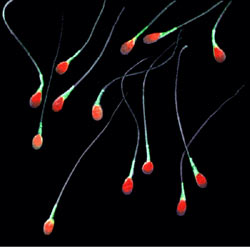|
The human reproductive system is a complex set of intertwining factors, many of which are required for sustained fertility. By interrupting even a single one of these required processes, we can find new ways to create exciting non-hormonal contraceptives for men. One key feature of sperm is their ability to swim through the reproductive tract. This ability, or sperm motility, is one of the most exciting targets of male contraception. Dead in the water – Stopping sperm motilitySperm motility is the ability of sperm to swim through the female reproductive tract in order to fertilize an egg. The tail of the sperm, the flagellum, is what gives sperm motility. Powered by Adenosine Triphosphate (ATP), the tail propels sperm towards its target by whipping back and forth. However, sperm don’t move in one single straight line. Sperm motility can be classified in different ways, such as straight-moving, zig zag, vibrating, or just non-motile. These different forms of motility move the sperm in different ways. Exposure to different signals change the guidance mechanism, ultimately guiding the sperm to the egg. Once the sperm nears the egg, they undergo a process called capacitation. This process is triggered by the presence of calcium, and induces a period of hyperactivation in the sperm. The flagella move with a high curvature and wavelength, propelling the sperm towards the egg. This step also begins destabilizing the acrosomal membrane, which is crucial for fertilization. Any drug that blocks sperm motility could bring about real change to the contraceptive world. These drugs could have a very short onset time, and might only need to be taken a short time before coitus. Also, because sperm demonstrate their motility in the female reproductive tract, women might be able to use this contraceptive as well, bringing true equity to the contraceptive landscape. There are many well-known targets of sperm motility that could be used for development of male contraceptives. Some under development right now include Eppin, The ion channel CatSper, and Na/K ATPase. MCI has funded some work into this space with Patricia Cuasnicu in Argentina. There’s more than one way to contracept.Reproduction is a big, complicated machine, with lots of ways to put a temporary hold on the process. Stopping sperm motility is one way that to make the next generation of male contraceptives. Other projects focused on preventing spermatogenesis, sperm transport, and fertilization are all being actively pursued. Together, we’re hopeful that these scientific ventures create multiple forms of male contraception with diverse product profiles that meet the needs of more users. Nuts & Bolts: Sperm Motility To learn more about, please visit our series of posts about male reproduction and contraception: For additional terminology related to male contraception and the male reproductive system, please visit our glossary: For additional publications related to male contraception and the male reproductive system, please visit our publications page:
0 Comments
Your comment will be posted after it is approved.
Leave a Reply. |
Categories
All
Archives
June 2024
|
|
|
Donate to Male Contraceptive InitiativeYour generous donation makes a difference!
|
© Male Contraceptive Initiative. All rights reserved.



 RSS Feed
RSS Feed
